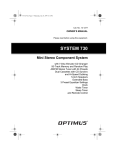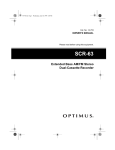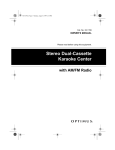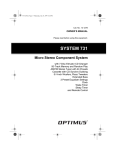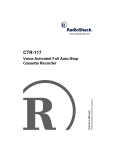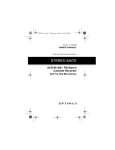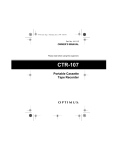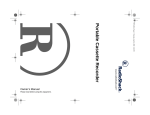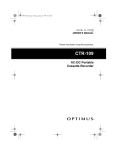Download Radio Shack CD-3315 Owner`s manual
Transcript
14-539.fm Page 1 Wednesday, June 30, 1999 1:50 PM Cat. No. 14-539 OWNER’S MANUAL Please read before using this equipment. CD-3315 Portable AM/FM Stereo Single Cassette Recorder with CD Player 14-539.fm Page 2 Wednesday, June 30, 1999 1:50 PM FEATURES Your Radio Shack CD-3315 Portable AM/FM Stereo Single Cassette Recorder with CD Player is an all-in-one music system. It is small and portable so you can take it anywhere, indoors or out. Anywhere you go, at work or play, you can listen to the radio, prerecorded cassette tapes, or compact discs, or even make your own recordings! CASSETTE DECK FEATURES Automatic Stop —protects the tape and tape-handling parts by automatically stopping the tape when it reaches the end. Soft Cassette Tape Eject — softly opens the cassette compartment door so the cassette does not pop out. One-Touch Recording —lets you start recording by pressing a single button. Automatic Level Control—auto-matically adjusts the recording level. Programmable Play—lets you program and play up to 20 tracks in any sequence. Repeat Play—lets you repeat a track, an entire CD, or a series of programmed tracks. OTHER SPECIAL FEATURES Extended Bass System—provides richer, fuller bass. Power Options—let you power your system from AC power or internal batteries. You can power it from your vehicle using an optional DC-to-AC inverter. For your records, we recommend you record the CD-3315’s serial number in the space below. The serial number is on the back of the CD3315. Serial Number: ________________ Read this manual carefully. It will help you get the most enjoyment from your system. Tri-Source Recording —lets you record from the CD player or radio, or make live recordings using the builtin microphone. CD PLAYER FEATURES Automatic Search Music System — lets you quickly find any track on a CD. 1995 Tandy Corporation. All Rights Reserved. Radio Shack is a registered trademark used by Tandy Corporation. 2 14-539.fm Page 3 Wednesday, June 30, 1999 1:50 PM Compact discs that you can play on your system’s CD player have this mark on them. Warning: To prevent fire or shock hazard, do not expose this system to rain or moisture. CAUTION Warning: This system employs a laser light beam. Only a qualified service person should remove the cover or attempt to service this device, due to possible eye injury. RISK OF ELECTRIC SHOCK. DO NOT OPEN. ! CAUTION: TO REDUCE THE RISK OF ELECTRIC SHOCK, DO NOT REMOVE COVER OR BACK. NO USER-SERVICEABLE PARTS INSIDE. REFER SERVICING TO QUALIFIED PERSONNEL. This symbol is intended to alert you to the presence of uninsulated dangerous voltage within the system’s enclosure that might be of sufficient magnitude to constitute a risk of electric shock. Do not open the system’s case. ! This symbol is intended to inform you that important operating and maintenance instructions are included in the literature accompanying this system. The graphical symbols with the supplemental markings are located on the back of the unit. 3 14-539.fm Page 4 Wednesday, June 30, 1999 1:50 PM 4 14-539.fm Page 5 Wednesday, June 30, 1999 1:50 PM CONTENTS POWER SOURCES 5 Using Internal Batteries 5 Using the AC Power Cord 6 Powering the CD-3315 In Your Home 6 Powering the CD-3315 In Your Vehicle 6 Cleaning the Tape-Handling Parts 18 Restoring Tape Tension and Sound Quality 18 SPECIFICATIONS 19 USING HEADPHONES 7 Listening Safely 7 Traffic Safety 7 RADIO OPERATION 8 CD PLAYER OPERATION 10 Loading/Unloading a CD 10 Playing a CD 10 Automatic Search Music System 11 Repeat Play 11 Programmed Play 12 Checking a Programmed Sequence 12 Editing a Programmed Sequence 12 CASSETTE PLAYER OPERATION 13 Playing a Cassette Tape 13 Recording 13 Recording from the CD Player 14 Recording from the Radio 15 Making Live Recordings 15 CARE AND MAINTENANCE 16 CD Care Tips 17 Tape Tips 17 Erasing a Cassette Tape 17 Preventing Accidental Erasure 17 5 14-539.fm Page 6 Wednesday, June 30, 1999 1:50 PM POWER SOURCES You can power the CD-3315 from: • Internal battery power, using six D batteries • Standard AC power, using the supplied AC power cord and an AC outlet or your vehicle and an optional DC-to-AC inverter USING INTERNAL BATTERIES You can power the CD-3315 from six D batteries (not supplied). For the best results, we recommend alkaline batteries, such as Radio Shack Cat. No. 23-550. 1. Press down on the two tabs above the battery compartment cover and pull out the cover to remove it. Cautions: • To protect the CD-3315 from possible battery leakage, never leave dead, weak, or old batteries in the CD-3315. • If you do not plan to use the CD-3315 for a month or more, or if you plan to use the external AC power cord, remove the batteries. 3. Insert six D batteries in the compartment as indicated by the polarity symbols (+ and –) marked above the compartment. Cautions: 2. If necessary, remove and dispose of the old batteries. • Use only fresh batteries of the recommended size and type. • Never mix fresh and old batteries. 4. Replace the battery compartment cover. Note: If the CD-3315’s sound weakens or distorts, replace the batteries. 6 14-539.fm Page 7 Wednesday, June 30, 1999 1:50 PM USING THE AC POWER CORD Powering the CD-3315 In Your Home Plug the supplied AC power cord into AC IN on the back of the CD-3315. Then plug the other end into a standard AC outlet. Powering the CD-3315 In Your Vehicle Convert your vehicle’s DC power to 120V AC using a DC-to-AC inverter, such as Radio Shack Cat. No. 22132 (not supplied). Follow the instructions included with the inverter to connect it to your vehicle’s cigarette-lighter socket. Then plug the supplied AC power cord into AC IN on the back of the CD-3315 and plug the other end into the AC outlet on the inverter. Caution: To avoid exposure to hazardous voltage, always plug the AC power cord into the CD-3315 before you plug it into the standard AC outlet. Always unplug the AC power cord from the standard AC outlet before you unplug it from the CD-3315. Caution: To avoid exposure to hazardous voltage, always plug the AC power cord into the CD-3315 before you plug the power cord into the inverter. Always unplug the AC power cord from the inverter before you unplug the power cord from the CD3315. Note: The CD-3315 automatically disconnects internal batteries when you connect the AC power cord. If the CD-3315 hums when you turn it off, just unplug the inverter from your vehicle’s cigarette-lighter socket. 7 14-539.fm Page 8 Wednesday, June 30, 1999 1:50 PM USING HEADPHONES For private listening, you can insert a pair of stereo headphones (not sup1 plied) with a /8-inch plug into the PHONES jack. LISTENING SAFELY To protect your hearing, follow these guidelines when you use headphones. • Set the volume to the lowest setting before you begin listening. After you begin listening, adjust the volume to a comfortable level. Notes: • Your local Radio Shack store carries a wide selection of stereo headphones. • Connecting headphones automatically disconnects the built-in speaker. • Do not listen at extremely high volume levels. Extended highvolume listening can lead to permanent hearing loss. • Once you set the volume, do not increase it. Over time, your ears adapt to the volume level, so a volume level that does not cause discomfort might still damage your hearing. TRAFFIC SAFETY Do not wear headphones while operating a motor vehicle or riding a bicycle. This can create a traffic hazard and is illegal in some areas. Even though some headphones are designed to let you hear some outside sounds when listening at normal volume levels, they still present a traffic hazard. 8 14-539.fm Page 9 Wednesday, June 30, 1999 1:50 PM RADIO OPERATION Warning: To protect your hearing, set VOLUME to its lowest setting before you turn on the radio. 4. Adjust TUNING to the desired station. 1. Set FUNCTION/POWER to RADIO. The POWER indicator lights, and the radio turns on. Notes: • For the best AM reception, rotate the CD-3315 to position the built-in AM antenna. 2. Set AM/FM to AM or FM. 3. Set FM MODE using these guidelines. • For the best FM reception, fully extend the telescoping antenna and swivel it to the position that produces the best reception. • If FM stereo reception gets noisy while FM MODE is set to STEREO, set FM MODE to MONO. The sound is no longer in stereo, but reception should improve. 5. Adjust VOLUME to a comfortable level. • To listen to FM stereo, set it to STEREO. The FM STEREO indicator lights when you receive a stereo FM broadcast. • To listen to FM monaural, set it to MONO. 9 14-539.fm Page 10 Wednesday, June 30, 1999 1:50 PM 6. Press E-BASS to ON for an enhanced bass effect. Press it to OFF for normal bass sound. 7. To turn off the radio, set FUNCTION/POWER to TAPE. The POWER indicator turns off. 10 14-539.fm Page 11 Wednesday, June 30, 1999 1:50 PM CD PLAYER OPERATION LOADING/UNLOADING A CD 1. Set FUNCTION/POWER to CD. nO appears on the display if no CD is loaded, and the POWER indicator lights. 2. Press PUSH OPEN to open the CD compartment door. PLAYING A CD Warning: To protect your hearing, set VOLUME to its lowest setting before you begin playing a CD. 1. Press PLAY/PAUSE to play all the tracks in order starting with Track 1. The current track number and the track’s elapsed time appear on the display. 3. Place a CD in the compartment with the label facing up. 4. Close the CD compartment door. ––_ _ _ _ flashes on the display, then the total number of tracks and the CD’s total playing time appear. 5. To remove the CD, press PUSH OPEN, grasp the CD by its edges, and carefully pull it out. Note: Press PLAY/PAUSE to temporarily stop the CD. PAUSE appears on the display. Press PLAY/PAUSE again to resume playing the CD. PAUSE disappears. 2. Adjust VOLUME to a comfortable level. 3. Press E-BASS to ON for an enhanced bass effect. Press it to OFF for normal bass sound. 4. Press STOP to stop playing the CD before all tracks have played. Wait a few seconds for the CD to stop turning, then press PUSH OPEN to open the CD compartment door and remove the CD. 11 14-539.fm Page 12 Wednesday, June 30, 1999 1:50 PM AUTOMATIC SEARCH MUSIC SYSTEM The automatic search music system lets you quickly locate the beginning of any track on the CD, including the track currently playing. If the CD is playing: • Press SKIP | to return to the beginning of the current track. • Press SKIP | to skip to the beginning of the next track. If the CD is stopped, repeatedly press SKIP | or | until the display shows the number of the track you want to play, then press PLAY/ PAUSE. The CD player starts playing the selected track. Note: At the beginning of a CD, you can only search forward. At the end of a CD, you can only search backward. 12 REPEAT PLAY You can repeat the current track, the entire CD, or a programmed sequence (see “Programmed Play”). To repeat the current track, press REPEAT once. REPEAT ONE appears on the display. The CD player continuously replays the current track. To repeat the entire CD, press REPEAT twice. REPEAT ALL appears on the display. The CD player continuously replays the entire CD. Note: If you have programmed a sequence in memory (see “Programmed Play”), pressing REPEAT twice replays the entire sequence. REPEAT ALL appears on the display. To cancel the repeat function, press REPEAT until REPEAT ONE and REPEAT ALL disappear from the display. 14-539.fm Page 13 Wednesday, June 30, 1999 1:50 PM PROGRAMMED PLAY You can program up to 20 tracks on a CD to play in any sequence you choose. Note: Be sure the CD player is stopped before you program tracks. 1. Press PROGRAM. through the programmed sequence. 6. To clear the program from memory, press STOP. Then set FUNCTION/POWER to TAPE. Or, simply press STOP twice. Checking a Programmed Sequence While the CD is stopped, repeatedly press PROGRAM to step through the programmed sequence. Editing a Programmed Sequence PROGRAM and – – P:01 appear on the display. 2. Press SKIP | or | to select the track you want to store in the first memory location (01). 3. Press PROGRAM. PROGRAM and – – P:02 appear on the display. 4. Repeat Steps 2 and 3 to program additional tracks. Note: When all 20 memory locations are used, the first programmed track reappears on the display. When this happens, any track you enter replaces the displayed track. To replace a track in a sequence, while the CD is stopped, repeatedly press PROGRAM until the track you want to replace appears on the display. Then press SKIP | or | until the desired track appears on the display, and press PROGRAM. To add to the end of the sequence, repeatedly press SKIP | until you reach the end of the sequence. Then follow Steps 2 and 3 in “Programmed Play.” 5. Press PLAY/PAUSE. The tracks play in the programmed order. PROGRAM, the current track number, and the track’s elapsed time appear on the display. Note: During play, you can press SKIP | or | to move 13 14-539.fm Page 14 Wednesday, June 30, 1999 1:50 PM CASSETTE PLAYER OPERATION PLAYING A CASSETTE TAPE Notes: Warning: To protect your hearing, set VOLUME to its lowest setting before you begin playing a cassette tape. • To temporarily stop play, press PAUSE. Press PAUSE again to resume play. 1. Set FUNCTION/POWER to TAPE. The POWER indicator turns off. • To rapidly wind the tape forward or backward, press FAST-F or REWIND. The cassette deck automatically stops at the end of the tape. 2. Press STOP/EJECT to open the cassette compartment door. • To manually stop play, press STOP/EJECT. The POWER indicator turns off. Press STOP/EJECT again to open the cassette compartment. 3. Load the cassette in the compartment with the open edge facing up and the full reel on the right. 4. Close the cassette compartment door. 5. Press PLAY. The POWER indicator lights. The cassette plays until it reaches the end of the side, then it automatically stops. 6. Adjust VOLUME to a comfortable level. 7. Press E-BASS to ON for an enhanced bass effect. Press it to OFF for normal bass sound. RECORDING You can record from the CD player or radio, or use the built-in microphone to make a live recording. Caution: Be sure the erase-protection tabs are in place on the cassette tape you are using to record. If you try to record on a cassette tape that has had the erase protection tabs removed, you cannot press RECORD. Do not force it, as this can damage the mechanism. See “Preventing Accidental Erasure.” 14 14-539.fm Page 15 Wednesday, June 30, 1999 1:50 PM Notes: • Most material on compact discs and prerecorded tapes is copyrighted. Unauthorized duplication of copyrighted material is a violation of the copyright laws of most countries and such duplication may result in fines and/or imprisonment. Note, however, that in the United States, it is not a violation of U.S. copyright laws for a consumer to use an audio recording device to duplicate musical recordings for noncommercial (personal) use. • Tape quality greatly affects the quality of the recording. For lownoise, wide range recordings, use normal-bias tape. • We recommend regular length (60- or 90-minute) cassette tapes. We do not recommend long-play cassette tapes, such as C-120s, because they are thin and easily tangle. • The system’s Automatic Level Control (ALC) automatically adjusts the recording level. VOLUME and E-BASS have no effect on recording. • You can record only specific tracks from a CD by first programming a sequence. See “Programmed Play.” Recording from the CD Player 1. Insert a blank cassette tape, or one you want to record over, into the cassette compartment. 2. Set FUNCTION to CD. 3. Load a CD into the CD compartment. 4. Press RECORD on the cassette tape deck. RECORD and PLAY lock down. The cassette deck starts recording. The CD pauses for 4 seconds, then begins playing. Note: To temporarily pause the recording, press PAUSE on the cassette deck. Press PAUSE again to resume recording. 5. To stop recording before the tape reaches the end, press STOP/EJECT on the cassette deck. 6. To stop the CD player before it automatically stops, press STOP on the CD player. 15 14-539.fm Page 16 Wednesday, June 30, 1999 1:50 PM Recording from the Radio 1. Follow Steps 1-4 under “Radio Operation.” 2. Insert a blank cassette tape, or one you want to record over, into the cassette compartment. 3. Press RECORD on the cassette deck. RECORD and PLAY lock down. The cassette deck starts recording from the radio. Notes: • To reduce or eliminate a whistling sound sometimes produced when recording AM broadcasts, set FM MODE/OSC to any of the three positions (1, 2 or 3) that give you the best sound quality. • To temporarily pause the recording, press PAUSE on the cassette deck. Press PAUSE again to resume recording. 4. To stop recording before the tape reaches the end, press STOP/EJECT on the cassette deck. 5. To turn off the radio, set FUNCTION/POWER to TAPE. 16 14-539.fm Page 17 Wednesday, June 30, 1999 1:50 PM Making Live Recordings Follow these steps to make live recordings using the built-in microphone. 1. Set FUNCTION/POWER TAPE. to 2. Load a blank cassette tape, or one you want to record over, into the cassette compartment. 3. Place the CD-3315 2–3 feet from the recording source. 4. Press RECORD to begin recording. RECORD and PLAY lock down. Note: To temporarily recording, press PAUSE. stop 5. To stop recording before the tape reaches the end, press STOP/EJECT. 17 14-539.fm Page 18 Wednesday, June 30, 1999 1:50 PM CARE AND MAINTENANCE Your Radio Shack CD-3315 Portable AM/FM Stereo Single Cassette Recorder with CD Player is an example of superior design and craftsmanship. The following suggestions will help you care for the system so you can enjoy it for years. CLEANER Keep the CD-3315 dry. If it gets wet, wipe it dry immediately. Liquids might contain minerals that can corrode the electronic circuits. Use and store the CD3315 only in normal temperature environments. Temperature extremes can shorten the life of electronic devices, damage batteries, and distort or melt plastic parts. Handle the CD-3315 gently and carefully. Dropping it can damage the circuit boards and can cause the system to work improperly. 18 Keep the CD-3315 away from dust and dirt, which can cause premature wear of parts. Wipe the CD-3315 with a damp cloth occasionally to keep it looking new. Do not use harsh chemicals, cleaning solvents, or strong detergents to clean the system. Modifying or tampering with the CD3315’s internal components can cause a malfunction and might invalidate its warranty and void your FCC authorization to operate it. If the CD3315 is not performing as it should, take it to your local Radio Shack store for assistance. 14-539.fm Page 19 Wednesday, June 30, 1999 1:50 PM CD CARE TIPS Even though a compact disc is durable, treat the CD surface with care. • Do not write on either side of the CD, particularly the non-label side (signals are read from the non-label side). • Do not store CDs in high temperature, high-humidity locations. They might warp. • Keep CDs dry. A water drop can act as a lens and affect the laser beam’s focus. • Always handle a CD by the edges to avoid fingerprints and always keep it in its protective case or sleeve when it is not in use. Fingerprints and scratches on the CD’s surface can prevent the laser beam from correctly reading the digital information. If the CD gets scratched, use Scratch ’n Fix (Radio Shack Cat. No. 42-127) to repair the disc. TAPE TIPS Erasing a Cassette Tape To erase a previously recorded tape, simply record over it. To erase the entire cassette tape, set FUNCTON/POWER to CD and do not load a CD. Then start recording and let the tape record to the end. To quickly erase both sides of a cassette tape, use a bulk tape eraser (such as Cat. No. 44-232, not supplied). Preventing Accidental Erasure Cassette tapes have two erase-protection tabs—one for each side. To protect a recording from being accidentally recorded over or erased, use a screwdriver to remove one or both erase-protection tabs. 19 14-539.fm Page 20 Wednesday, June 30, 1999 1:50 PM To record on a tape side after you remove the erase-protection tab, place a piece of strong plastic tape over that side’s erase-protection hole. Be sure you cover only the hole originally covered by the tab. Note: Removing the erase-protection tabs does not prevent a bulk eraser from erasing a cassette tape. RADIO SHACK LIMITED WARRANTY This product is warranted against defects for 90 days from date of purchase from Radio Shack company-owned stores and authorized Radio Shack franchisees and dealers. Within this period, we will repair it without charge for parts and labor. Simply bring your Radio Shack sales slip as proof of purchase date to any Radio Shack store. Warranty does not cover transportation costs. Nor does it cover a product subjected to misuse or accidental damage. EXCEPT AS PROVIDED HEREIN, RADIO SHACK MAKES NO EXPRESS WARRANTIES AND ANY IMPLIED WARRANTIES ARE LIMITED IN DURATION TO THE DURATION OF THE WRITTEN LIMITED WARRANTIES CONTAINED HEREIN. Some states do not permit limitation or exclusion of implied warranties; therefore, the aforesaid limitation(s) or exclusion(s) may not apply to the purchaser. This warranty gives you specific legal rights and you may also RADIO SHACK A Division of Tandy Corporation Fort Worth, Texas 76102 3A5 Printed in Hong Kong 14-539.fm Page 21 Wednesday, June 30, 1999 1:50 PM CLEANING THE TAPE-HANDLING PARTS RESTORING TAPE TENSION AND SOUND QUALITY Dirt, dust, or particles of the tape’s coating can accumulate on the tape heads and other parts that the tape touches. This can greatly reduce the performance of the cassette player. Use the following cleaning procedure after every 20 hours of tape player operation. After you play a cassette tape several times, the tape might become tightly wound on the reels. This can cause playback sound quality to deteriorate. 1. Disconnect all power sources. 2. Open the cassette compartment door. 3. Press PLAY to expose the tapehandling parts. 4. Use a cotton swab dipped in denatured alcohol or tape head cleaning solution to clean the record/play head, pinch roller, capstan, and erase head. To restore the sound quality, fast-forward the tape from the beginning to the end of one side, the completely rewind it. Then loosen the tape reels by gently tapping each side of the cassette’s outer shell on a flat surface. Caution: Be careful not to damage the cassette when tapping it. Do not touch the exposed tape or allow any sharp objects near the cassette. 5. When you finish cleaning, press STOP/EJECT and close the cassette compartment door. Your local Radio Shack store sells a complete line of cassette cleaning products. 21 14-539.fm Page 22 Wednesday, June 30, 1999 1:50 PM SPECIFICATIONS GENERAL Power Supply120V AC, 60 Hz or Six D Batteries Harmonic Distortion 2% Output Power (10% THD) 1 Watt × 2 Channels Dimensions 65/16 × 181/2 × 91/16 Specifications are typical; individual units might vary. Specifications are subject to change and improvement without notice. Inches (HWD) (160 × 470 × 230 mm) Weight (without Batteries) 9 lbs 6 oz (4.25 kg) RADIO Frequency AM: 530-1710 kHz FM: 88-108 MHz CASSETTE DECK Tape Speed 17/8 ips Tape System 4-Track Stereo Recording System AC Bias Erasing System Permanent Magnet Erase Head CD PLAYER Number of Tracks grammed 20 to be Pro- Frequency Response ± 3 dB at 61 Hz to 16 kHz Signal-To-Noise 65 dB Sampling Frequency 44.1 kHz Oversampling 2 Times 22






















